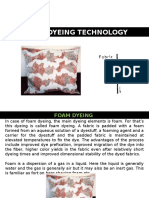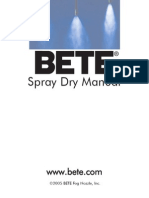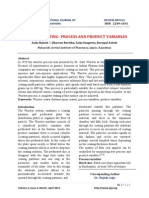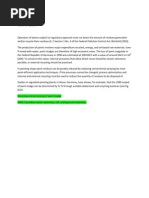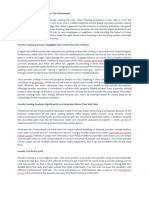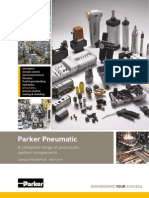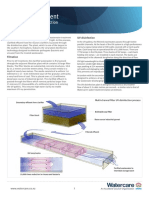Papers: Drying of Dyestuffs and Pigments
Papers: Drying of Dyestuffs and Pigments
Uploaded by
blackshark432Copyright:
Available Formats
Papers: Drying of Dyestuffs and Pigments
Papers: Drying of Dyestuffs and Pigments
Uploaded by
blackshark432Original Title
Copyright
Available Formats
Share this document
Did you find this document useful?
Is this content inappropriate?
Copyright:
Available Formats
Papers: Drying of Dyestuffs and Pigments
Papers: Drying of Dyestuffs and Pigments
Uploaded by
blackshark432Copyright:
Available Formats
PAPERS
Spray drying of dyestuffs and pigments
Keith Masters
Niro Atomizer, Gladsaxevej 305, PO Box 45, DK-2860 Soeborg, Denmark
INTRODUCTION Spray dying involves the atomisation of the dyestuff
In the production of many dyestuffs and pigments a dying and pigment feedstock into a spray of droplets, and
stage is required to convert liquid feedstocks into bringing the spray into contact with drying air. Feedstocks
powdered products, which can be either intermediate or can be in solution, suspension or paste form, but must be
finished products. One of the most suitable industrial pumpable. The atomisation process creates an extensive
methods to achieve this requirement is spray dying. surface area for heat and mass transfer, which enables
Spray dying is characterised by maintenance of low rapid evaporation of moisture from the spray droplets
product tvmperatures during the dying operation, even while suspended in the air flow. Dying times are short,
when the temperature of the incoming air is high. It is thus product retention time in the spray dying chamber is also
ideal for dyestuff and pigment formulations that contain short, and particle temperatures remain low. The process
heat-sensitive additives such as dispersing agents, level- is illustrated in Figure 1.
ling agents, binders, etc., as well as for inorganic
feedstocks containing no organic materials. Feed
Dyestuft and pigment feedstocks that require dying
vay considerably in terms of solids content and rheology. Hot drying air* Air dispenser
The powder specifications of the end product are v e y
precise. Fortunately the spray dying process has been *.*** Atomiser
Spray droplets
developed to such a degree that, today, a design of spray
dyer is available to produce any type of powder, i.e.
standard, dustless or agglomerated. Even if the spray Dried particles, Drying chamber
. *
dryer cannot achieve the powder specification alone, then
spray dying can be combined with another dying
technique. e.g. fluid-bed dying, in two-stage processing
to achieve the powder specificaton. Exhaust air
The flexibility of spray dying has played a leading role
in establishing its use in the dyestuff and pigment industry.
It has replaced contact dying techniques in many cases
because of its ability to handle organic formulations and
meet precise particle size and low-dust specifications in
automateti, safe and reliable plant that causes no air Powder discharge
pollution. It also features strongly within inorganic
pigment dying, since spray dying offers important Figure 1 - Spray drying system
advantages: (a) low energy costs due to use of high inlet
dying temperatures, (b) both low and high production This dying technique originated in the late 19th
rates can be achieved in a single plant, and (c) both centuy, but industrial applications of any importance first
abrasive and non-abrasive pumpable feedstocks can be became established in the 1920s. V e y little literature has
handled been published on the spray dying of dyestuffs, and only
Typical spray-dried dyestuffs and pigments are listed a brief reference exists establishing that attempts to adapt
below: this dying technique to dyestuffs began in the 1930s. In
Acid dyes Lead chromate (chrome the last two decades, numerous patents involving spray
Azoic dyes ye 11ow) dying have been filed [l].
Barium sulphate Iron oxide (black, red, This paper gives an overview of how spray d y e r design
Basic dyes yellow) is meeting the needs of today’s industry.
Calcium c,-irbonate (and Kaolin
related tillers) Lead molybdate BASIC PRINCIPLES
Cadmium carbonate Lithopone In the spray drying operation the liquid to be removed is
Cadmium sulphide Phthalocyanines usually water. The removal of organic solvents by spray
Ceramic colorants Reactive dyes dying is also a fully established industrial operation, as
Disperse dyes Titanium dioxide solvent-based dyestuff formulations exist. The dying
Dyestuff intermediates Zinc chromate principles involved for both water and non-water systems
Food colorants Zinc potassium chromate are the same.
JSDC Volume 104 February 1988 79
The moisture in a dyestuff or pigment droplet can be the central area of the wheel rotating at high speed, then
present in two forms: bound and unbound moisture. The accelerated to the wheel edge where atomisation takes
nature of the solid and accompanying moisture deter- place due to frictional forces between liquid and air in this
mines the dying characteristics. The bound moisture in turbulent region. Droplet size is controlled by the wheel
the solid exerts an equilibrium vapour pressure lower than speed, with higher speeds reducing size. Feed rate has a
that of the pure water at the same temperature. Water very small effect on droplet size within the feed rate
retained in small capillaries in the solid, or chemically variations occurring in a given spray dying operation.
combined with the solid as product water of cystalli- Various wheel designs are used for dyestuffs and
sation, falls in the categoy of bound moisture. The pigments. Wheels with radial vanes (Figure 3 ) are for
unbound moisture in a hygroscopic material is that non-abrasive formulations. The curved vane design
moisture in excess of the bound moisture. All water in a (Figure 4) often produces higher bulk powders than the
non-hygroscopic material is unbound water, which exerts straight vane type. Bushing wheels (Figure 5) are f o r
an equilibrium vapour pressure equal to that of pure abrasive formulations. The bushings are made of carbide
water at the same temperature. The equilibrium moisture or alumina material so that the feed only flows over
is the moisture content of a product when it is at abrasion-resistant surfaces. The power consumption of a
equilibrium at the partial pressure of the water vapour of rotay atomiser varies with feed rate and square of the
the surroundings. The free moisture is the moisture in wheel speed at fixed wheel diameter.
excess of the equilibrium moisture and consists of Of the two nozzle types, pressure nozzles are the more
unbound and some bound moisture. Only free moisture important. Two-fluid designs are used only to a small
can be evaporated during spray dying. extent, in low-capacity applications where v e y fine
The mechanism of moisture flow through a droplet powders are accceptable. In the pressure nozzle the feed
during spray dying is by diffusion, supplemented by is pumped under pressure to the nozzle head, causing t h e
capillary flow. The dying characteristics of the droplet feed to leave the orifice as a high-speed film that readily
depend upon whether bound or unbound moisture is disintegrates into droplets. Droplet sizes produced vary
evaporated, as each has distinct features. As long as inversely with applied pressure and directly with feed rate
unbound moisture exists, dying proceeds at a constant and viscosity. The capacity varies with the square root of
rate and will continue while the rate of moisture diffusion pressure. Unlike rotay atomisers, high capacities cannot
within the spray droplet is fast enough to maintain be accomplished in single-nozzle designs, but require
saturated surface conditions. When diffusional and capil- multi-nozzle assemblies that complicate d y e r start-up,
l a y flows can no longer maintain these conditions, the operation and shut-down.
critical point is reached, and the dying rate will decline
until the equilibrium moisture content is attained. The
equilibrium moisture content will remain unchanged
while the product is exposed to the same atmospheric
humidity and temperature.
Evaporation thus takes place from the saturated vapour
film that is quickly established at the droplet surface.
Droplet surface temperatures are low, approximating to
the wet-bulb temperature of the dying air. Evaporation
takes place under so-called constant and falling rate
conditions. Dyer chamber design must provide a suffi-
cient droplet residence time to enable completion of
moisture removal without heat degradation of product.
During the evaporation stage the atomised spray distribu-
tions undergo change as droplets either collapse, expand,
fracture or lose sphericity, depending upon their rheology
and the temperature gradients to which they are subjec- Figure 2 - Rotary atomiser in operation
ted. Information on the flow and temperature of air and
product for assessing d y e r evaporative capacity is
obtainable from heat and mass balance data.
Organic formulations are generally characterised by
short constant rate and extended falling rate dying
periods, while with inorganic feedstocks surface moisture
evaporation and short dying times under virtually
constant rate conditions are typical.
The atomisation stage represents the heart of the spray
dying operation. Devices for producing sprays of con-
trolled droplet size utilise centrifugal, pressure or kinetic
energy in rotay wheel atomisers, pressure nozzles and
two-fluid nozzles.
The rotay atomiser is the most widely used device,
being ideal for handling both abrasive and non-abrasive
feedstocks at either low or high capacities. Such an
atomiser is shown operating in Figure 2. Liquid is fed into Figure 3 - Straight-vaned atomiser wheel
80 JSDC Volume 104 Februay 1988
spray dyers using rotary or pressure nozzle atomisers are
as follows:
(a) For spray dyers with rotary atomiser, the mean size
of the dried product varies between 40 and 120 pm
(larger mean product sizes can be produced in large
chamber diameters)
(b) For a pressure nozzle atomiser, the mean size of the
dried product varies between 120 and 300 pm.
Figures 6 and 7 show the spherical nature of spray-
dried dyestuffs, and size differences between typical rotary
atomiser and pressure nozzle operations. The product of
the latter is less dusty and more free-flowing. Further
improvement can be achieved by forming agglomerated
powders, or by utilising fluid beds within the spray dying
Figure 4 f 'urved-vaned atomiser wheel chamber (see Figure 8(d))or mounted externally.
Figure 5 ~ Rushing wheel
The choice of atomiser for a given dyestuff or pigment
figure 6 - Twjcal spray-dried powders produced with a rotary
application, however, depends upon the particle size atomiser
distrubution required in the final dried product. In cases
where rotary and nozzle atomisers produce similar
parttcle sile distributions, the rotary atomiser is always
preferred because of its greater flexibility and ease of
operation The rotay atomiser has distinct advantages:
(a) It handles high feed rates without need for atomiser
duplication
(b) It handles abrasive feedstocks without wear problems
(c) It has negligible blockage or clogging tendencies due
to the large flow ports in the atomiser wheel
(d) It is a low-pressure system, which means a simpler
associated feed system
(e) The droplet size control is through simple adjustment
to wheel speed.
The flexibility of the rotary atomiser (i.e. feed rate
fluctuations do not affect particle size) and the ease of
control of particle size distribution through simple
adjustment of wheel speed are perhaps the most
important advantages of the rotay atomiser over the
pressure nozzle equivalent.
However, in the vast majority of cases, it is the particle
size distribution requirements of the final product that
determines what type of atomiser is used in spray dying. Figure 7 - Typical spray-dried powders produced with a
Guidelincs for the primay particle sizes obtainable in pressure nozzle
JSDC Volume 104 Februay 1988 81
The manner in which droplets or particles of dyestuffs
and pigments come into contact with the dying air and
move through the dying chamber influences the tem-
perature to which the dried product is subjected. The
dying chamber design and method of air introduction are
selected according to grain size specification and heat
sensitivity, and this means that only co-current and mixed
flow designs are feasible (Figure 9). Of the two, the
co-current represents the majority of operational plants,
since temperature levels in the dying chamber are always
close to the required outlet dying temperature in order to
achieve the desired residual moisture content. This is
irrespective of the inlet dying temperature level.
SPRAY DRYING SYSTEMS FOR ORGANIC DYE-
STUFFS AND PIGMENTS
Spray dying of soluble dyes (including reactive dyes) and
vat, azoic and disperse dyes is a typical application. Inlet
dying temperatures are selected according to the heat
sensitivity of the product. Highly heat-sensitive dyestuffs
are produced at an inlet temperature of about 130°C.
Other less heat-sensitive formulations can be handled at
inlet temperatures of up to 450°C. The spray-dried
powder consists of hollow individual particles or ag-
glomerates. The powder form is brittle, enabling easy
dispersion into dissolvers or similar aggregates. The
desired moisture content can be generally achieved in the
spray d y e r alone, but special extra low moisture contents,
or low powder temperatures, often require two-stage
dying involving second-stage fluid bed processing. The
(a) Standard spray dryer with rotary atomiser spray d y e r design and layout are selected according to
Ib) Standard spray dryer with interchangeable rotary and nozzle atomiser powder size distribution, operational safety and environ-
Ic) Tall-form nozzle spray dryer
(d) Fluidised spray dryer mental specifications. The particle size/form governs
which dying chamber design and atomiser is to be used.
Figure 8 - Spray dryer layouts used in dyestuff and pigment Fines recovey is normally conducted in cyclones, which
-I
dying
are easy to clean and enable different dyestuff for-
mulations to be dried in the same spray dyer. Wet
scrubbers are mounted after cyclones to remove the
traces of powder leaving the cyclones with the exhaust air.
However, wet scrubbers can create an effluent problem,
and if production rates for a given formulation are small,
then it is quite common to install several small spray
dyers, each equipped with a bag filter to operate on one
or two selected colours. This overcomes the cleaning and
colour contamination problem associated with the use of
Y
a bag filter, while conferring the benefits of near-perfect
degree of powder recovey and avoidance of atmospheric
emissions of fine particles.
Co-current
The particle size requirements of spray-dried organic
dyestuffs/pigments are met through correct choice of the
atomiser and dying chamber design (Table 1). For
J?
products in the range of the size mean 40-120 pm,
standard chamber designs having a diameter/cylindrical
height ratio (DH) of 0.6-1:l are used, incorporating
.-. ,.*.
rotay atomisers (Figure 81a)). Mean size variation is
achieved in this design through adjustment of the rotay
atomiser speed. The larger the chamber diameter, the
slower the atomiser speed that can be used, and the
coarser the product produced without creating un-
acceptable wall deposits of semi-dried material.
For mean sizes greater than 120 p m low-pressure
nozzle atomisers are used in versatile or tall-form (tower)
Counter-current M i x e d (combined)
designs (Figure 8(b and c)). The versatile design of the
Figure 9 - Three main types o f spray dyers dying chamber (D.H=l: 1-1.3) is particularly attractive to
82 JSDC Volume 104 Februay 1988
TABLE 1 High-capacity cyclones are used for primay product
recovey. In this case the secondary collector can be
Particle size requirements for dyestuffs and either a high-efficiency cyclone or a bag filter, depending
pigments on the application. The final product is discharged under
Mean pitticle flow control from the integrated fluid bed. A variable-
size (rlrn) Soraw drver tune Associated atomiser speed rotay valve is controlled via the pressure drop
40 120 Standard Rotary across the fluidised layer, which is a direct indication of
40 -700 Versatde Rotary and pressure nozzle the mass of product within the bed. The product is
1% 100 Tall-form Pressure nozzle normally in an agglomerated form and must therefore be
150- 100 Integrated fluid bed Rotary or pressure nozzle handled in an appropriate transport system. Dense-phase
laoalomisrated) conveying (i.e. the pneumatic conveying of powder in a
pressurised system) has proved to be acceptable for most
the organic dyestufflpigment industries since, by being applications, but the preferred system involves the use of
able to interchange rotay and nozzle atomisers, it is tote bins as powder containers for intermediate storage
possible to achieve a wide range of product sizes in cases and transport. Figure 10 illustrates the particle size
where numerous gradelfeed types have to be produced distributions obtainable from the spray d y e r design
in the same spray d y e r installation. referred to above; typical mean particle sizes are given in
Only nozzle atomisation can be used in tall-form dyers. Table 1.
This d y e r design (DH 1:3-4) can produce the coarsest
particle sizes (mean size up to 300 km). There is also
some chance of heat affecting coarser products due to the
prevailing temperature distribution, and slightly higher
r- A
outlet trmperatures are needed in dying the coarse
particles down to the required low moisture content
levels.
The wer-competitive need to produce, under low
product temperature conditions, even better non-dusty,
free-flowing, coarse powders of individual particles or
agglomerates has necessitated the development of a new
spray d y e r design concept during the past two years. This
is a spray d y e r featuring an integrated fluid bed. The
Particle size
Fluidized Spray D y e r (FSD) is such a plant (Figure 8(d)).
The F:SD system features downward-firing pressure figure 10 - Comparison of particle size dist~butionof organic
nozzles (rotay atomisers suitable in large capacity dyers) dyestuffproduced on standard (curveA), tall-form(curve B), and
located in a roof-mounted air disperser. Primay dying fluidised (curve C)spray dryers
takes place in the conventional manner, but the partially
dried product, still having a significant moisture content, Another major consideration is safe handling during
passes directly into an established fluidised powder layer. dying, since many organic dyestufflpigment powders are
This results in extremely low outlet temperatures from the classified as potentially explosive as mixtures in air. Some
dying system combined with controlled second-stage feedstocks also are based on organic solvents that present
dying, which takes place within a fluid bed built into the explosion and fire risks during dying. For all such
base of the dying chamber, to achieve the desired powders and feedstocks two special spray dying systems
moisture content. The product from the FSD can be are available in which dying takes place in an inert (low
after-cooled or post-dried in a vibrating fluid bed. oxygen) atmosphere, evaporated volatiles (water or
A novel feature of the FSD design is the removal of the solvent) recovered and the dying medium conditioned in
exhaust air from the roof of the dying chamber. Fine a scrubberlcondenser. The two systems are (a) a
material elutriated from the fluidised bed is carried within semi-closed cycle system for water-based feedstocks that
the air flow and is deposited as a powder on the surface of can be dried in plants incorporating direct-fired heating,
the dying chamber and dying product droplets, thereby i.e. powder can come into contact with products of
limiting wall deposit formation. A proportion of the combustion without quality deterioration, and (b) a closed
elutriateil fines comes into contact with the cloud of cycle (gas-tight) system for organic solvent-based feed-
atomiseci droplets resulting in agglomeration prior to stocks.
entering the fluidised layer. The fine material separated The semi-closed system creates its own inert atmos-
from the exhaust air is recycled to the dying chamber for phere through precise control of the amounts of combus-
further iigglomeration. The process produces a dustless tion air used at the direct-fired heater. As shown in Figure
free-flowing powder with a mean particle size ranging 11, the aqueous feedstock is atomised in the dying
from approximately 150 to 700 km, depending upon chamber and dried product collected at the chamber
product characteristics. base. Fines entrained in exhaust dying gas leaving the
The high moisture content of the product entering the chamber are collected in cyclone or bag filter. Exhaust gas
fluid bed results in v e y low product temperatures and is conditioned in the scrubberlcondenser, where water
allows much higher inlet temperatures to be considered. evaporated in the dying chamber is recovered. Con-
The resultant increase in inlet temperature and reduction ditioned dying gas is recycled to the direct-fired heater. A
in outlet temperature gives a significant improvement in volume of gas equivalent to that of the combustion
operating heat economy. products created at the heater is bled from system to
JSDC Volume 104 February 1988 83
maintain constant dying gas flow through the dying Successful spray dying requires control of the scrubbing/
chamber. Low oxygen content in dying gas (less than condensing stage at precise temperatures. Correct condi-
4'%) is created by the heater through precise combustion tions usually can be obtained by use of available cooling
air control. Direct heating allows high inlet temperatures water or brine if high boiling point solvents are involved.
to be used, thus achieving high d y e r heat economy. The For low boiling point solvents, solvent cooling utilising a
dying chamber is operated under slight vacuum. cooler/compressor system may be needed. Plant is
constructed to be gas-tight, operating under a slight
pressure to prevent inward leakage of air. However, slight
loss of inert gas does occur in closed cycle layout primarily
at the product off-take point.
If a powder to be dried from an aqueous feedstock is
411 considered potentially a low explosion and fire risk, thus
not justifying the extra expense of semi-closed and closed
C o m b u s t i o n air cycle technology, standard open cycle systems can be
used. These should be fitted with pressure-release venting
and fire suppression devices in the d y i n g chamber and
d y powder collectors. Alternatively all components
I
1
Condensed' containing airborne powder can be constructed to meet
w '3 t e r r e c Over y design standards governing resistance to pressure shock.
By far the majority of spray d y e r s installed before 1980
I
P r o d tic t S c r u b b e r c on d e n s c r were standard designs without any safety features. The
greater appreciation of the hazards involved with organic
Fiyure 11 Semi-closed cycle spray dryer capable of creating its
~
formulations is leading to a rapid tightening of safety
own inert atmosphere
standards, with old plant being refitted, and new
installations designed to appropriate standards.
Drying c h a m b e r In any spray dying application with organic dyestuffs
FV6.d Indirect heater Heat exchanger and pigments the intensity of colours produced by even
\ Coollnq
the finest of particle sizes results in a highly visual
environmental problem if particles leave the d y e r
entrained in the exhaust air. Preventing emissions to the
atmosphere of organic dyestuff and pigment particulate
matter (powder fines) is thus a prime requirement of these
industries, not only to prevent visual pollution, but also to
prevent toxic emissions in cases where formulations are
poisonous. Powder recovey must be optimised. For this
i
s0 I v e "t\ reason high-efficiency d y and wet collectors are always
recovery
used. For operations involving multi-colour batches a
cyclone/wet scrubber, cartridge filter o r bag filters in
Product Scrubber condenser I parallel (one for each colour) are incorporated in the d y e r
layout for product recovey and final air cleaning of fines.
Fiyure 12 Closed cycle spray dryer with inert dying medium
~
A single conventional bag filter is preferred where
single-colour batches are processed in the same d y e r .
The closed cycle (gas-tight) system uses nitrogen to Particulate emissions occur because the separation
create an inert dying medium, eliminating all explosion efficiency of d y or wet collectors is never 100%. For
and fire risks associated with the solvent. Complete cyclones it is up to 98% and for bag filters up to 99.9'%,.
solvent recovey is a main feature of the system, which is Thus, even when such equipment is working under ideal
in use in the dyestuff industry. As shown in Figure 12, the conditions, some powder escapes collection and passes to
feed-containing solids in solution or suspension in organic the atmosphere. This is why wet scrubbers are always
liquid (or mixture) are pumped to the atomiser (rotay or fitted after cyclone collectors to clean the exhaust air
nozzle). Spray immediately makes contact with a flow of further, and sometimes after bag filters to guard against
inert gas, solvent evaporates leaving dried particles powder emission should bag rupture occur.
suspended in the dying gas. Powder is recovered outside Powder loading in the exhaust air, expressed as powder
the chamber in cyclones or gas-tight bag filters, while weight per unit air volume, is v e y low when using
exhaust dying gas, containing evaporated organic high-efficiency equipment and meets current require-
vapours and traces of particles, passes to a scrubber/ ments. However, if large air flows are involved, a
condenser prior to being recycled back to the dying considerable weight loss of powder can occur even
chamber through an indirect heater (steam or liquid though the efficiency of air cleaning equipment is optimal.
phase). Conditioning and solvent recovey through Such emission levels reduce d y e r yield, besides creating
condensation are achieved by supplying the same organic an emission problem in terms of amount of powder
liquid (but cooled) to the scrubber/condenser and emitted per hour.
bringing it into contact with the dying gas flowing One of the ways of reducing powder emissions and
counter-currently. The only solvent loss is traces left in the establishing a pollution-free system is the adoption of
dried powder as residual volatile content. Condensed semi-closed cycle techniques (Figure 11). With this
solvent is collected at the scrubber/condenser overflow. technique only a small proportion of the total exhaust air
84 JSDC Volume 104 February 1988
in the system is vented to the atmosphere. This vented Feed
volume will contain a very small amount of particulate -1
matter. but the total weight of such particulate emission
will be riegligible compared with d y e r product output.
The venird volume is taken from the recycling air, which
has already passed through a bag filter (or cyclone) and Air
scrubber condenser arrangement. +c
Figure 11 shows a pollution-free dying system. It
assumes the organic dyestuffs/pigments can come into
Product
contact with the products of combustion without quality
detrimrnt. Should this not be so, semi-closed systems (a) Product (b)
involving indirect heating are available, and in this case
vented [olumes are even smaller than in the layout (a) High-temperature spray dryer for inorganic pigment featuring central
depicted in Figure 11. air disperser and bag filter
!b) Low-capacity spray dryer for producing coarse-grain inorganic
pigments
SPRAY DRYING OF INORGANIC PIGMENTS
Inorganic- pigments differ significantly from their organic Figure 13 - Spray dryer layouts for inorganic pigments
counterpxts by being less heat sensitive and being dried
in much higher-capacity plant. Many inorganic pigment best applied to low-capacity operations, where a multi-
feeds are abrasive and are available only as suspensions nozzle arrangement can be avoided. The production of
with higli solids content, pastes or wet cakes. Dyer coarse powder grains will only be possible if the pigment
designs (tre chosen to achieve optimum performance formulation has sufficient self-binding properties, or
through rhe use of high-feed solids and high inlet air contains binder additives to provide the particle strength
temperatirres to minimise the heat consumption per unit for withstanding powder break-up through attrition during
weight of pigment produced. mechanical handling, transport and storage.
The niost suitable spray d y e r design is selected
accordinci to the rheology of the feed, the specified CONCLUSION
evaporative duty, acceptable inlet dying air temperatures An extensive range of dyestuffs and pigments is spray
and desirtjd particle size. dried today. Due to the differing product characteristics,
A rotaty atomiser is preferred when feedstocks are either open, semi-closed or closed cycle layouts have to
abrasive ,rnd have a high solids content, with diaphragm be used to meet the important requirements regarding
pumps feeding the pigment to the atomiser. Work particle size and low dust content, while meeting
softening in a special paddle mixer, conical orbital screw operational safety and pollution-free dying obligations.
mixer or high shear mixer is adopted where a pseudo- Particle size requirements are met through the correct
plastic filter cake has to be dried. Screw-type pumps are choice of dying chamber design and associated atomiser.
suitable lor non-abrasive feed slurries, and centrifugal Powders of low dust content are obtained through correct
pumps ftieding a stand-pipe with flow control via a choice of the atomiser system or by adopting additional
diaphrayrn valve are adequate where feeds flow readily. processing methods such as dedusting with oils, but the
Rotary dtomisers are used in co-current dying chamber new developments with integrated fluid bed spray dying
designs. which prevent heat damage to possible organic now enables dustless agglomerates to be obtained directly
additives in the feed. For applications that permit inlet from the spray dying chamber.
temperatirres above 600°C the hot dying air is introduced Operational safety is met through correct choice of the
directly under the atomiser wheel (Figure 13(a)). spray d y e r layout, the open, semi closed or closed cycle
For applications specifying inlet temperatures below layouts being chosen according to the nature of the
600”C, the atomiser is located within the roof-mounted air feedstock (aqueous or solvent based), the classification of
disperser Drying air passes down over the atomiser powder as an explosive and fire risk in air mixtures, and
wheel. Rotary atomiser operation produces fine to whether for reasons of quality the powder can be brought
medium-c oarse pigment powders, and powder collection into contact with products of combustion.
directly ir; a bag filter is often preferred, especially when Pollution-free requirements are met through use of
spray-drkd toxic pigments contain lead, cadmium or zinc. high-efficiency d y collectors and wet scrubbers, and for
In case> where a coarse powder grain is required, and special demands of negligible emission losses by use of
the feed.dock is pumpable to a degree to permit semi-closed cycle layouts.
low-pressure atomisation, nozzles are used in mixed flow REFERENCE
dying ch.3mber designs (Figure 13(b)).This approach is 1. ‘Spray dying handbook’. 4th Edn (London: George Godwn, 1985) 493
JSDC Volume 104 February 1988 85
You might also like
- Spray DryingDocument30 pagesSpray Dryingpriyanka minjNo ratings yet
- Ink ChemistryDocument12 pagesInk Chemistrydeepanairbalachandra0% (2)
- Training Papers Spray Drying enDocument19 pagesTraining Papers Spray Drying enJuan LlabotNo ratings yet
- Introduction To Advanced CompositesDocument24 pagesIntroduction To Advanced Compositesagox194100% (1)
- A Primer On Spray Drying Chemical Engineering Nov09Document7 pagesA Primer On Spray Drying Chemical Engineering Nov09Hikmah Triana HadiNo ratings yet
- A Primer On Spray DryingDocument7 pagesA Primer On Spray DryingAnonymous 1zdRSWskhgNo ratings yet
- Tall Form Spray Dryer by RichiezDocument34 pagesTall Form Spray Dryer by RichiezRichard Obinna100% (1)
- Foam DyeingDocument23 pagesFoam DyeingMr.X100% (1)
- Spray Dry Manual: ©2005 BETE Fog Nozzle, IncDocument25 pagesSpray Dry Manual: ©2005 BETE Fog Nozzle, IncDarwin Barra TorresNo ratings yet
- Key Words-Atomization, Air Disperser, Dry Emulsion, Granulation, Aerosols, Fluidized SprayDocument27 pagesKey Words-Atomization, Air Disperser, Dry Emulsion, Granulation, Aerosols, Fluidized SprayBasanth NadellaNo ratings yet
- Spray DryingDocument23 pagesSpray DryingclenglimNo ratings yet
- Spray DryingDocument48 pagesSpray DryingKantilal Narkhede100% (3)
- BF 02673402Document7 pagesBF 02673402Angela Lorena DíazNo ratings yet
- Pollution-Free Printing InksDocument2 pagesPollution-Free Printing InksKashif JavedNo ratings yet
- FGD Chemistry: Basic PrinciplesDocument7 pagesFGD Chemistry: Basic Principlesirvan Chaerul SNo ratings yet
- Long Question/ Narrative Question.: Define Pigment?Document3 pagesLong Question/ Narrative Question.: Define Pigment?Hau LeNo ratings yet
- Vat PrintingDocument15 pagesVat Printingimran24No ratings yet
- Paint Spray and Powder Coating Processes: Hanover Risk SolutionsDocument14 pagesPaint Spray and Powder Coating Processes: Hanover Risk SolutionsalammasoodNo ratings yet
- Wet ScrubbersDocument31 pagesWet ScrubbersJoao MinhoNo ratings yet
- Concise Guide To Powder CoatingDocument32 pagesConcise Guide To Powder CoatingUgoRibeiro0% (1)
- 41-Drying of SC PDFDocument8 pages41-Drying of SC PDFWaleed KhanNo ratings yet
- Preparation of Ink PDFDocument7 pagesPreparation of Ink PDFsathishNo ratings yet
- Direct, Acid and VatDocument3 pagesDirect, Acid and Vatnahidulbutex002No ratings yet
- Spray-Drying: Basic Theory and ApplicationsDocument15 pagesSpray-Drying: Basic Theory and ApplicationsDarkwraith007100% (1)
- DriersDocument5 pagesDriersAnimesh BhowmikNo ratings yet
- Solvent Dyeing PDFDocument23 pagesSolvent Dyeing PDFDhrubo Adhikary100% (2)
- Ink ChemistryDocument38 pagesInk ChemistryBharati100% (1)
- How Does Spray Dryer WorkDocument5 pagesHow Does Spray Dryer WorkugandaNo ratings yet
- Powder Coating PDFDocument56 pagesPowder Coating PDFMalathi ISO100% (1)
- Powder Coating: Albert G. HolderDocument7 pagesPowder Coating: Albert G. Holdervvpvarun100% (1)
- Voc Report - MembersDocument40 pagesVoc Report - MembersmehoNo ratings yet
- Formulation of Highly Concentrated Suspensions For Spray Drying in A Fluidized BedDocument12 pagesFormulation of Highly Concentrated Suspensions For Spray Drying in A Fluidized BedVishnupriya RamalingamNo ratings yet
- Spray Drying and Spray PyrolysisDocument19 pagesSpray Drying and Spray Pyrolysisirakool2014No ratings yet
- Textile TechnologyDocument5 pagesTextile TechnologyKaye NicolasNo ratings yet
- Dry Powder Coating A New Trend in Coating TechnologyDocument11 pagesDry Powder Coating A New Trend in Coating TechnologyTimir PatelNo ratings yet
- FoamsDocument14 pagesFoamsJavier Danilo Aranda PinzonNo ratings yet
- Mist Elimination and Phase SeparationsDocument28 pagesMist Elimination and Phase SeparationsSales SES OmanNo ratings yet
- 2008 First Urea Granulation Plant in BrazilDocument12 pages2008 First Urea Granulation Plant in BrazilEnrique CastañedaNo ratings yet
- Printing Ink and ManufactureDocument13 pagesPrinting Ink and ManufactureD Rong sa100% (1)
- Wurster Coating-Process and Product VariablesDocument6 pagesWurster Coating-Process and Product VariablesMaría Reynel TarazonaNo ratings yet
- Boost ConvertorDocument5 pagesBoost ConvertorFaizan MalikNo ratings yet
- Powder Coating Is A Type of Coating That Is Applied As A Free-Flowing, Dry Powder. The Main DifferenceDocument2 pagesPowder Coating Is A Type of Coating That Is Applied As A Free-Flowing, Dry Powder. The Main Differenceashar077No ratings yet
- Thermal DOD: Canon Hewlett-Packard Lexmark ThermalDocument3 pagesThermal DOD: Canon Hewlett-Packard Lexmark Thermaldwarika2006No ratings yet
- Water Based Inks For Flexographic PrintingDocument7 pagesWater Based Inks For Flexographic PrintingNur Anis HidayahNo ratings yet
- Paint SludgeDocument11 pagesPaint SludgePratik Dewan100% (1)
- Guidance For Controlling Silica Dust From Stone Crushing With Water Spray Technology - For Employers PDFDocument7 pagesGuidance For Controlling Silica Dust From Stone Crushing With Water Spray Technology - For Employers PDFAfqan B-vNo ratings yet
- Paint Products and Finish ProductsDocument17 pagesPaint Products and Finish ProductsSheree LabeNo ratings yet
- Atomization For Spray Drying Unanswered Questions and Industrial NeedsDocument6 pagesAtomization For Spray Drying Unanswered Questions and Industrial NeedsNicolas Pardo AlvarezNo ratings yet
- Review on Spray Drying TechnologyDocument8 pagesReview on Spray Drying Technology18101918No ratings yet
- Forced Circulation Evaporator Final ReportDocument40 pagesForced Circulation Evaporator Final ReportManvi SharmaNo ratings yet
- Powder Coated (Low Voc)Document3 pagesPowder Coated (Low Voc)Lyz RomeroNo ratings yet
- Glass Beads PDFDocument20 pagesGlass Beads PDFShivaranjani KuruparanNo ratings yet
- LTM 3 CDRDocument4 pagesLTM 3 CDRJuliaNofadiniNo ratings yet
- SWP SolveDocument4 pagesSWP SolveMd. Abdullah Al MarzanNo ratings yet
- What Is Powder CoatingDocument4 pagesWhat Is Powder Coatingrayray8095No ratings yet
- 7 Quencher DesignDocument8 pages7 Quencher DesignJozsef Acs100% (1)
- The French Polisher's Manual - A Description of French Polishing Methods and TechniqueFrom EverandThe French Polisher's Manual - A Description of French Polishing Methods and TechniqueNo ratings yet
- Analisys and application of dry cleaning materials on unvarnished pain surfacesFrom EverandAnalisys and application of dry cleaning materials on unvarnished pain surfacesNo ratings yet
- Roll-to-Roll Manufacturing: Process Elements and Recent AdvancesFrom EverandRoll-to-Roll Manufacturing: Process Elements and Recent AdvancesJehuda GreenerNo ratings yet
- Water-based Acrylic Dispersions: Applications in Architectural CoatingsFrom EverandWater-based Acrylic Dispersions: Applications in Architectural CoatingsNo ratings yet
- IPC-TM-650 Test Methods Manual: Association Connecting Electronics IndustriesDocument3 pagesIPC-TM-650 Test Methods Manual: Association Connecting Electronics IndustriesFern BaldonazaNo ratings yet
- TLP241A DatasheetDocument18 pagesTLP241A DatasheetKyan LawNo ratings yet
- Chemistry Project On Study of AdulterantDocument19 pagesChemistry Project On Study of AdulterantKártìk KhatriNo ratings yet
- Vanillin Know HowDocument8 pagesVanillin Know HowRegulatory IndaromaNo ratings yet
- Technische Information - COSMOFIN-FG R - ENDocument2 pagesTechnische Information - COSMOFIN-FG R - ENKat PNo ratings yet
- Q4 Science 10 Module 2Document26 pagesQ4 Science 10 Module 2Francine Alburo80% (5)
- Shear Resistance of RC Circular Members With FRP Discrete Hoops Versus SpiralsDocument16 pagesShear Resistance of RC Circular Members With FRP Discrete Hoops Versus Spiralser.praveenraj30No ratings yet
- ColaDet LPCDocument1 pageColaDet LPCmndmattNo ratings yet
- Vermeer - Pocket Welding InstructionsDocument2 pagesVermeer - Pocket Welding InstructionsNaveen TheerthalaNo ratings yet
- Department of ChemistryDocument2 pagesDepartment of Chemistrymamondal0% (5)
- Case Study of Supporting Tube FailureDocument6 pagesCase Study of Supporting Tube FailuremakhdzaniNo ratings yet
- Textile Dictionary by Md. Jakir HossenDocument152 pagesTextile Dictionary by Md. Jakir HossenMd. Jakir HossenNo ratings yet
- Corrosion and PreventionDocument46 pagesCorrosion and Preventionmahek guptaNo ratings yet
- Lecture Note - Enzyme InhibitorDocument10 pagesLecture Note - Enzyme InhibitorBright ChimezieNo ratings yet
- The Calcination of Kaolin ClayDocument7 pagesThe Calcination of Kaolin ClaytaghdirimNo ratings yet
- Astm B906Document16 pagesAstm B906Jamil SalmanNo ratings yet
- WTP Schematic DiagramDocument3 pagesWTP Schematic DiagramRhys PalmaNo ratings yet
- Parker Pneumatic CatalogueDocument809 pagesParker Pneumatic CatalogueEdo NurkanovicNo ratings yet
- MTBE SynthesisDocument3 pagesMTBE SynthesisThắng MinerNo ratings yet
- Fermentation and Alcohol ProductionDocument24 pagesFermentation and Alcohol Productionfanus100% (2)
- K00933 - 20181107122127 - Topic 10 - IsomerismDocument41 pagesK00933 - 20181107122127 - Topic 10 - Isomerismmuhammad syahmiNo ratings yet
- 04 Crystallization of Magma - Magmatic DifferentiationDocument20 pages04 Crystallization of Magma - Magmatic DifferentiationartdeezoneNo ratings yet
- COT-DLL Types of Chemical ReactionDocument7 pagesCOT-DLL Types of Chemical ReactionFrancisco D. AndaquigNo ratings yet
- 4 Stoichiometry PDFDocument8 pages4 Stoichiometry PDFHakim Abbas Ali Phalasiya100% (1)
- CMOS-LOCOS - 01 Manual PDFDocument53 pagesCMOS-LOCOS - 01 Manual PDFFernando Sánchez HernándezNo ratings yet
- Tertiary Treatment: Ultraviolet (UV) DisinfectionDocument2 pagesTertiary Treatment: Ultraviolet (UV) DisinfectionlkokodkodNo ratings yet
- Wisconsin Construction Specification 23. Aluminum or Steel Roof GuttersDocument5 pagesWisconsin Construction Specification 23. Aluminum or Steel Roof GuttersAntonio PagaNo ratings yet
- Material Safety Data Sheet: Chemical Product and Company IdentificationDocument13 pagesMaterial Safety Data Sheet: Chemical Product and Company IdentificationGizlena Moreno RestrepoNo ratings yet
- Plant Codes - 010620Document26 pagesPlant Codes - 010620Sandip ChaudhuriNo ratings yet







